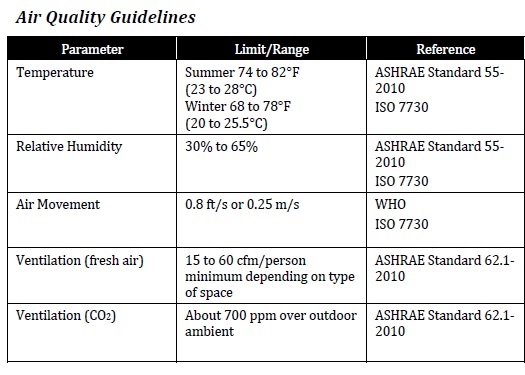WHO guidelines cover annual and daily concentrations of fine particulates nitrogen dioxide sulfur dioxide carbon monoxide and ozone WHO 2005. The background level of CO 2 outdoors is generally believed to be in the range of 350-500 parts per million ppm.
In a well-managed indoor space they are generally 350- 1000ppm.

Indoor air quality levels. Inadequate ventilation can increase indoor pollutant levels by not bringing in enough outdoor air to dilute emissions from indoor sources and by not carrying indoor air. Anzeige The atmospheric consequences of human activities the impact on human ecological health. Indoor Air Quality Americans spend up to 90 percent of their time indoors where contaminants in bioaerosols are generally at higher levels than those found in out-door air.
Poor indoor air quality IAQ has been tied to symptoms like headaches fatigue trouble concentrating and irritation of the eyes nose throat and lungs. Indoor pollution sources that release gases or particles into the air are the primary cause of indoor air quality problems in homes. Use a moisture or humidity gauge available at most hardware stores to see if the humidity in your home is at a good level.
So its a little odd that we dont think more about indoor air quality. All building-related factors equipment and occupant or maintenance practices that may impact indoor air quality will be considered andor reviewed and assessed. Keep indoor humidity between 30 and 50 percent.
CO 2 and humidity. Also some specific diseases have been linked to specific air contaminants or indoor environments like asthma with damp indoor environments. Go above 1000ppm and this is when people will start to.
Ventilation strategy to control. Assessing the health risks of indoor air pollution is very difficult as indoor air may contain over 900 chemicals particles and biological materials with potential health effects. Looking at the figures.
Indoor relative humidity should be maintained at or below 65. Levels and may serve as a benchmark for indoor air quality. The human health impacts of indoor air quality IAQ depend on multiple variables but are closely related to pollutant levels eg.
Factors like ventilation cleaning conditions building characteristics products used in households cultural habits climate and outdoor environment all influence indoor air quality. Frequently the duration of exposure to such contaminants also is greater indoors than out. To increase humidity use a vaporizer or humidifier.
Assessing indoor air quality. The EPA recommends humidity levels of between 30 and 60 to reduce mold growth. For example high humidity keeps the air moist and increases the likelihood of mold.
Levels for indoor environments should generally not exceed 5 ppm. Outdoor air is the subject of titanic legal and regulatory battles going back decades. Anzeige The atmospheric consequences of human activities the impact on human ecological health.
Consequently this indicator aims to provide an approach to ensuring suitable IAQ by addressing a number of different performance aspects namely. Levels below 1000 ppm indicate that there is adequate air circulation for indoor environments. Research indicates 96 percent of homes have at least one type of indoor air quality issue.
Dust Volatile Organic Compounds VOCs etc and air conditions eg. 100 ppm STEL ASHRAE. ASHRAE recommends temperatures ranging from 685 to 75 degrees Fahrenheit in the winter and from 75 to 805 degrees in the summer.
5000 ppm TWA ASHRAE. It is estimated that more than 30 percent of buildings in the United States and Western. An indoor air quality IAQ monitor will report on the levels of common pollutants and other air.
Benefits a diverse audience of researchers public health officials policy makers. WHO sets recommended limits for health-harmful concentrations of key air pollutants both outdoors and inside buildings and homes based on global synthesis of scientific evidence. Benefits a diverse audience of researchers public health officials policy makers.
